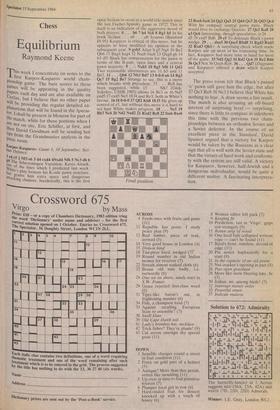Chess
Equilibrium
Raymond Keene
TThis week I concentrate on notes to the . first Karpov-Kasparov world cham- pionship game. The bare scores to these
games will be appearing in the quality Papers each day and are also available on Ceefax, but I believe that no other paper
Will be providing the regular detailed ex- Planations that will be found in the Specta- tor. I shall be present in Moscow for part of
the match, while for those portions when I am not on site, Eric Schiller, at first, and then David Goodman will be sending hot tills from the Grandmaster analysts in the press room.
•
nillan rPov-Kasparov- Game 1, 10 September; Sici-
Defence. •
1 e4 c5 2 Nf3 e6 3 d4 cxd4 4Nxd4 Nf6 5 Nc3 d6 6 g4 The Scheveningen Variation, Keres Attack, (,),1!e. of the lines which 1 predicted last week. hlte's play loosens his K-side pawn structure, attacking grants him extra space and dangerous attacking chances. Incidentally, this is the first
open Sicilian to occur in a world title match since the last Fischer-Spassky game in 1972! This in itself is an indication of the aggressive mood of both players. 6 . . . h6 7 h4 Nc6 8 Rgl h5 In his book Sicilian . . . e6 . . do Systems (Batsford £8.95) Kasparov is critical of this•move, but he appears to have modified his opinion in the subsequent year. 9 gxh5 After 9 g5 Ng4 10 Bc2 QM 11 Bxg4 hxg4 12 Nxc6 hxc6 13 Qxg4 g6 14 b3 d5! Black has compensation for the pawn in terms of the B-pair, open lines and a central pawn majority. 9 . Nxh5 10 Bg5 Nf6 11 Qd2 Two reasonable alternatives are 11 h5 and 11 Bet. 11 . Qb6 12 Nb3 Bd7 13 0-0-0 a6 14 Rg3 Qc7 15 Bg2 Bel Strange to say, this is a move which breaks with precedent. 15 . . . Rc8 has been suggested, while 15 . . . Nh7 (Glek- Sokolov, USSR 1983) allows 16 Be3 or 16 Nd5 exd5 17 exd5 Ne5 18 f4 and Re3, both in White's favour. 16 f4 0-0-0 17 Qf2 Kb8 18 f5 He gives up control of e5, but without this move it is hard to see how White makes progress. 18 . . . Ne5 19 Bh3 Nc4 20 Nd2 Nxd2 21 Rxd2 RcS 22 fxe6 Bxe6 Final position 23 Bxe6 fxe6 24 Qgl Qa5 25 Qd4 Qc5 26 Qd3 Qc4 With his • compact central pawn mass. Black would love to exchange Queens. 27 Qe3 Ka8 28 a3 Qc6 Interesting, though speculative, is 28 . . . d5 29 exd5 Bd6. 29 eS To dislocate Black's pawn wedge. 29 . . . dxe5 30 Qxe5 Rhd8 31 Rgd3 Rxd3 32 Rxd3 Qhl+ A surprising check which made Karpov use up most of his remaining time. In fact, Kasparov had more time in hand for most of the game. 33 Nd1 Qg2 34 Rd2 Qc6 35 Reg Bd6 36 Qc3 Not 36 Qxc6 Re8. 36 . . . Qd7 (Diagram) and Kasparov offered a draw which Karpov accepted.
The press room felt that Black's passed 'e' pawn still gave him the edge, but after
37 Qe3 Re8 38 Nc3 I believe that White has nothing to fear. A draw seems a fair result. The match is also arousing an off-board interest of surprising level — surprising, since there is little to compare in sideshows this time with the previous two cham- pionships between an orthodox Soviet and a Soviet defector. In the course of an excellent piece in the Standard, David Spanier argued that a victory for Karpov would be taken by the Russians as a clear sign that all is well with the Soviet state and that the virtues of hard work and conformi- ty with the system are still valid. A victory for Kasparov, however, half-Jewish and a dangerous individualist, would be quite a different matter. A fascinating interpreta- tion.


















































 Previous page
Previous page